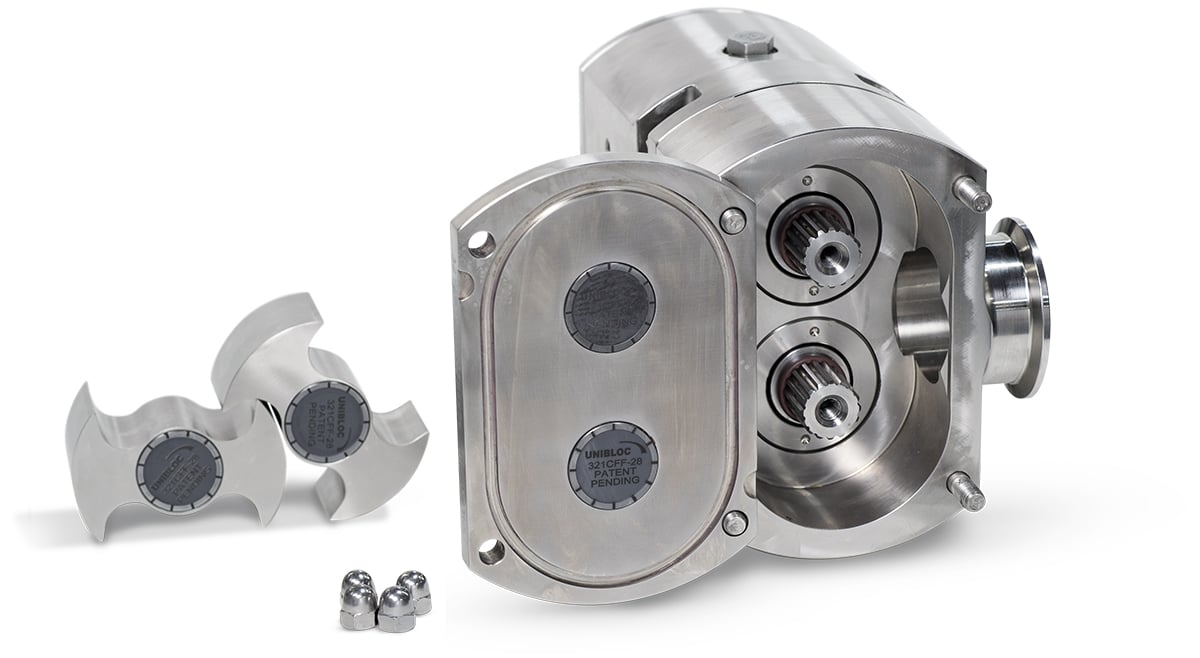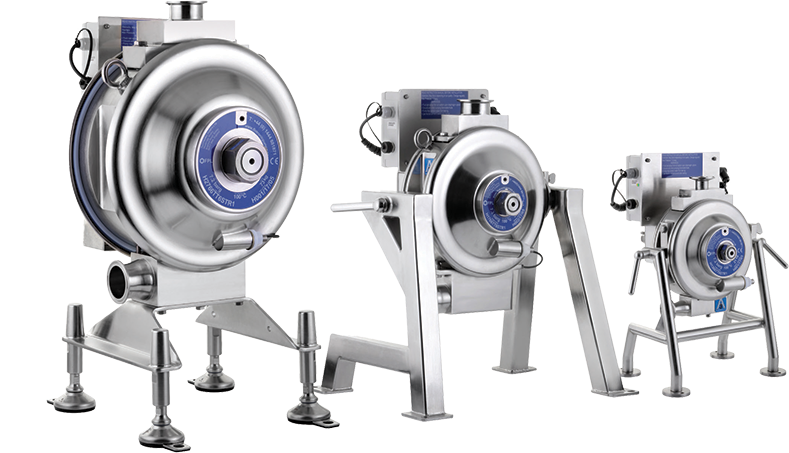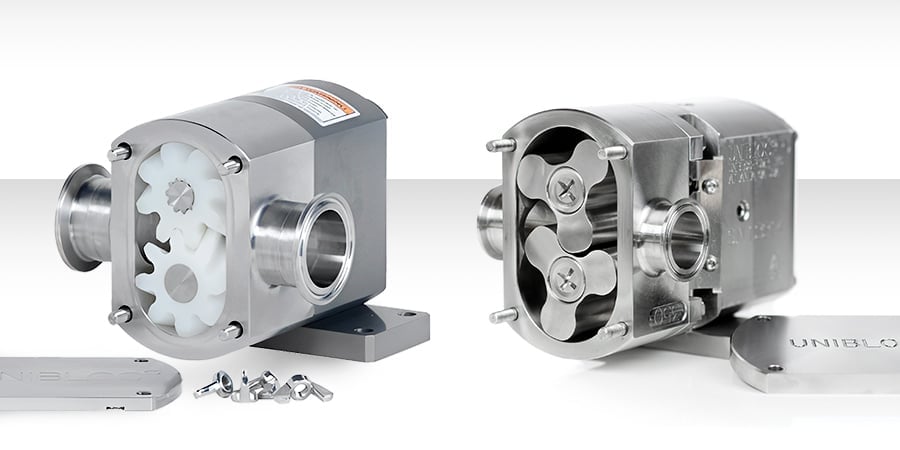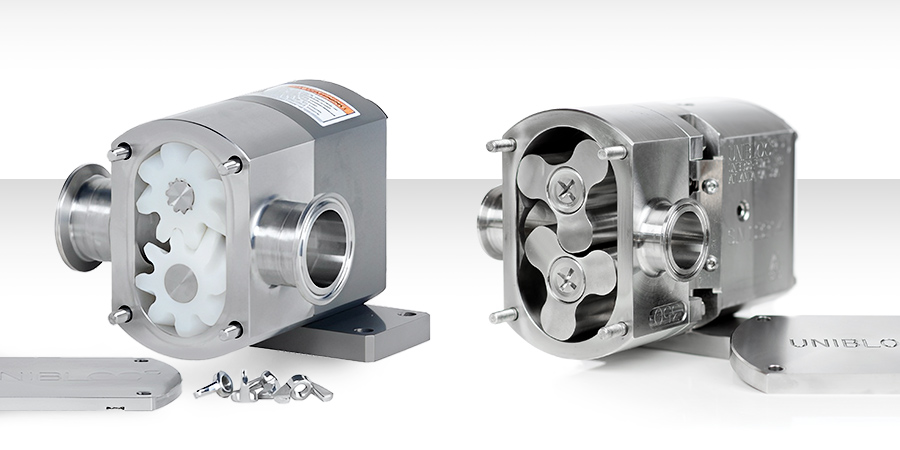
A “wetted” gear touches the fluid being pumped. The fluid fills the space between the gear teeth as they rotate, creating a seal and facilitating the pump action. As the gears rotate, the fluid is drawn into the pump’s inlet and transported between the gear teeth, ultimately discharging through the outlet.
Gear pumps are commonly used for filling and metering applications due to the precise and consistent flow characteristics facilitated by the action of their gears. Because the gears interlock, it creates discrete chambers that trap and transport a fixed amount of liquid as they rotate.
Applications that require precise dosing, mixing, or metering benefit from this aspect of gear pump operation, such as chemical manufacturing, pharmaceuticals, or consumer products. The more abrasive the material, the more it can wear on the gears, therefore gear pumps are not generally recommended for highly abrasive substances.
What is a lobe pump?
Lobe pumps also are positive displacement pumps, but this style pump employs lobed rotors instead of gears. Unlike a gear pump, the lobes never touch. The rotors move in opposite directions within a casing, and as they turn, fluid is drawn into the cavities formed by the lobes, and transported around the casing. Lobe pumps are known for the gentle handling of shear-sensitive fluids. This design makes lobe pumps a popular choice within the food, pharmaceutical, and cosmetic industries.
Some of the features of a lobe pump include low pulsation, high sanitary standards, and the ability to handle viscous fluids. A rotary lobe pump, for example, can handle highly viscous fluids of up to 200,000 Centipoise (cP).
Due to their shear sensitivity, lobe pumps handle food and beverage products like sauces, syrups, chocolate, and dairy products such as cream, butter or yogurt, or fruit pulp. The gentler action helps maintain product integrity and quality.
Within the pharmaceutical industry, lobe pumps transfer delicate biopharmaceutical products including creams, ointments, and suspensions.
From gentle handling to its ability to handle abrasive fluids, lobe pumps also make an excellent choice for resins, adhesives, paints, and polymers. Their robust construction makes them suitable for demanding chemical processing environments.
Unibloc Hygienic Technologies engineered a lobe pump with a patented rotor for low shear applications. Its ultra-hygienic design is seamless and porosity free, for a CIP or SIP capable pump. This sleek design eliminates any pinches or gaps to prevent the collection of hazardous microorganisms or buildup of materials. This design is suitable for the most rigorous processing and cleaning situations for 3A sanitary applications. The non-galling rotors mitigate the risk of foreign materials and wear.
A deeper dive into viscosity
The viscosity measures the thickness of a substance, or its resistance to flow. One of the considerations for pump selection is its ability to handle a material’s viscosity; however, this should never be the sole determinant for pump selection.
A substance might have one viscosity at room temperature, for example, but a very different viscosity when heated, or experiencing friction due to the pumping mechanism. Other factors include temperature, pressure, and the nature of the fluid or the velocity gradient.
The velocity gradient is otherwise called the shear rate and refers to the change in velocity of a fluid as it moves. Distance or position can cause a change in velocity. In addition, adjacent layers of fluid move at different velocities. This creates shear forces and results in deformation of the fluid’s flow characteristics. For example, a fluid with a higher velocity gradient will exhibit a greater difference in velocity between adjacent layers, leading to higher shear forces and increased internal friction within the liquid itself. It will move more slowly orated to the velocity gradient.
Design makes the biggest difference
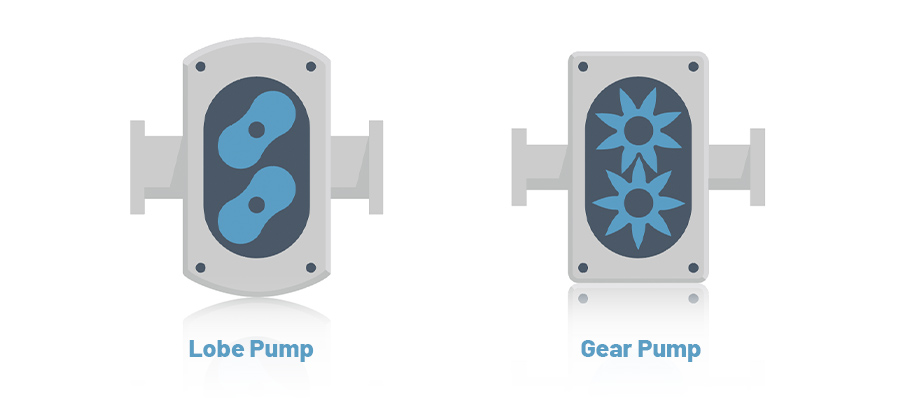
To recap, one of the primary distinctions between gear pumps and lobe pumps is the design of the activity. Gear pumps have a simpler construction, comprising of two gears that mesh together, while lobe pumps feature more complex rotor shapes.
The gear pump design enables precise and consistent flow rates, making it suitable for applications that require accurate measurements, such as a filling station. Lobe pumps, with their specialized rotor design, excel in handling delicate and shear-sensitive fluids without causing damage, rendering them ideal for industries where product integrity is crucial. These design differences give each pump type its unique capabilities.
Maintenance features
Selecting a positive displacement pump that offers easier maintenance can help mitigate the impact of labor shortages, which are affecting every industry. Simplified maintenance requires less specialized knowledge or training reduces downtime, improves workers’ safety and positively impacts productivity and profitability.
Both gear style pumps and lobe pumps from Unibloc Hygienic Technologies are available with its patented QuickStrip® design. Features of this unique design:
- Adheres to meticulous FDA cleaning requirements
- Allows tool-free access to pump head and seals
- Improves accuracy via its one-way assembly
- Reduces risk of damage due to simpler design
- Mitigates damage from foreign materials
Lobe and gear pumps differ in their operation, design features, and suitability for different applications. When considering pump style for a new or changing application, talk to our engineering staff to pin down the various factors that can influence or determine the best pump selection.
Unibloc Hygienic Technologies focuses on designing and building high quality pumps with design features that supply solutions to common pump challenges. This enables smoother operations, easier maintenance and greater productivity. We build a variety of pump styles in different styles, and can help you select the right pump to best suit your application. Call Unibloc Hygienic Technologies today.


